Low-Carbon and Energy-Saving Path Optimization Scheduling of Material Distribution in Machining Shop Based on Business Compass Model
Abstract
:1. Introduction
2. Workshop Material Distribution Based on Business Compass
2.1. Business Compass
2.2. Workshop Material Distribution Management Based on Business Compass
3. Material Distribution Calculation Model
3.1. Calculation Model of Energy Consumption
3.2. Carbon Emissions Calculation Model
3.3. Model Assumptions and Constraints
- (1)
- There is only one vehicle for distribution in each required working place.
- (2)
- The material demand on each path should not exceed the carrying weight of the vehicle.
- (3)
- Distribution vehicles (distribution personnel) leave from the distribution center.
- (4)
- The distribution vehicles (distribution personnel) return to the distribution center after finishing the distribution.
4. Dung Beetle Optimizer
4.1. Dung Beetles Roll a Ball
- (1)
- When there is no obstacle in front of dung beetles, dung beetles will navigate according to the light source during dung ball rolling. Assuming that the intensity of the light source will affect the position of dung beetles, the position of dung beetles during dung ball rolling will be updated as follows:
- (2)
- When a dung beetle has an obstacle in front of it, it needs to dance to realign itself to get a new route. The tangent function is used to simulate the dancing behavior so as to obtain a new rolling direction, which is only considered between [0, π]. Once the beetle has successfully determined its new direction, it should continue to roll the ball backward. The beetle’s position is updated as follows:
4.2. Dung Beetle Reproduction
4.3. Dung Beetle Foraging
4.4. Dung Beetle Stealing
- (1)
- Initialize the parameters of the dung beetle population and DBO;
- (2)
- Calculate the fitness values of all target agents according to the objective function;
- (3)
- Update the position of all dung beetles;
- (4)
- Determine whether each target agent exceeds the boundary;
- (5)
- Update the current optimal solution and its fitness value;
- (6)
- Repeat the above steps until t meets the termination criteria, and output the optimal global solution and its fitness value.
5. Case Study
5.1. Material Distribution in Workshop
5.2. Optimization Results and Analysis
5.3. Comparison with Previous Literature
6. Conclusions
- Based on the model of the business compass, the workshop material distribution management model was established, and the enterprise management process to realize the material distribution was analyzed.
- A material distribution calculation model based on energy consumption and carbon emission was established.
- Using DBO to solve this problem model, the comparison of DBO, NSGA- II, and GA shows the advantages of DBO; the algorithm has good global search ability and high search accuracy and can effectively optimize the material distribution route of manufacturing workshops. The effectiveness of the algorithm was verified by a case of material distribution in an engine assembly workshop.
Author Contributions
Funding
Institutional Review Board Statement
Informed Consent Statement
Data Availability Statement
Conflicts of Interest
References
- Ai, X.F.; Jiang, Z.G.; Zhang, H.; Wang, Y. Low-carbon product conceptual design from the perspectives of technical system and human use. J. Clean. Prod. 2020, 244, 118819. [Google Scholar] [CrossRef]
- Xia, T.; An, X.; Yang, H.; Jiang, Y.; Xu, Y.; Zheng, M.; Pan, E. Efficient Energy Use in Manufacturing Systems—Modeling, Assessment, and Management Strategy. Energies 2023, 16, 1095. [Google Scholar] [CrossRef]
- Liu, H.; Fan, L.; Shao, Z. Threshold effects of energy consumption, technological innovation, and supply chain management on enterprise performance in China’s manufacturing industry. J. Environ. Manag. 2021, 300, 113687. [Google Scholar] [CrossRef] [PubMed]
- Fatemeh, F.; Afshar, N.B. A bi-objective green location-routing model and solving problem using a hybrid metaheuristic algorithm. Int. J. Logist. Syst. Manag. 2018, 30, 366–385. [Google Scholar]
- Xu, L.A.; Wang, N.A.; Ling, X.B. Study on Conflict-free AGVs Path Planning Strategy for Workshop Material Distribution Systems. Procedia CIRP 2021, 104, 1071–1076. [Google Scholar]
- Li, S.; Zhao, H. Optimization of Material Distribution Path of Manufacturing Workshop Based on IPSO Algorithm. Mach. Des. Manuf. 2019, 10, 209–212. [Google Scholar]
- Farooq, B.; Bao, J.; Raza, H.; Sun, Y.; Ma, Q. Flow-shop path planning for multi-automated guided vehicles in intelligent textile spinning cyber-physical production systems dynamic environment. J. Manuf. Syst. 2021, 59, 98–116. [Google Scholar] [CrossRef]
- Wang, C.L.; Wang, Y.; Zeng, Z.Y.; Lin, C.Y.; Yu, Q.L. Research on Logistics Distribution Vehicle Scheduling Based on Heuristic Genetic Algorithm. Complexity 2021, 2021, 8275714. [Google Scholar] [CrossRef]
- Liu, S.; Zhang, Y.; Liu, Y.; Wang, L.; Wang, X.V. An ‘Internet of Things’ enabled dynamic optimization method for smart vehicles and logistics tasks. J. Clean. Prod. 2019, 215, 806–820. [Google Scholar] [CrossRef] [Green Version]
- Yan, Z.; Meu, F.; Ge, M. Path optimization method of workshop logistics based on fuzzy soft time windows. Comput. Integr. Manuf. Syst. 2015, 21, 2760–2767. [Google Scholar]
- Tong, F.; Xu, J. Two-way material distribution path planning for intelligent workshops considering workstation priority. J. Mech. Electr. Eng. 2021, 38, 1465–1471. [Google Scholar]
- Goel, R.; Maini, R. A hybrid of Ant Colony and firefly algorithms (HAFA) for solving vehicle routing problems. J. Comput. Sci. 2018, 25, 28–37. [Google Scholar] [CrossRef]
- Zhu, F.; Cao, T. Optimization Method of Material Delivery Path in Workshop Based on Time Window Constraints. Mach. Des. Manuf. 2023, 1, 136–139. [Google Scholar]
- Erdodu, K.; Karabulut, K. Bi-objective green vehicle routing problem. Int. Trans. Oper. Res. 2022, 29, 1602–1626. [Google Scholar] [CrossRef]
- Jie, K.W.; Liu, S.Y.; Sun, X.J. A hybrid algorithm for time-dependent vehicle routing problem with soft time windows and stochastic factors. Eng. Appl. Artif. Intell. 2022, 109, 104606. [Google Scholar] [CrossRef]
- Tarhini, A.; Danach, K.; Harfouche, A. Swarm intelligence-based hyper-heuristic for the vehicle routing problem with prioritized customers. Ann. Oper. Res. 2022, 308, 549–570. [Google Scholar] [CrossRef]
- Ren, X.; Huang, H.; Feng, S.; Liang, G. An improved variable neighborhood search for bi-objective mixed-energy fleet vehicle routing problem. J. Clean. Prod. 2020, 275, 124155. [Google Scholar] [CrossRef]
- Wang, R.P. Business Compass; Science Press China: Beijing, China, 2020. [Google Scholar]
- Sun, X.P. Taoism Naturalistic Technology Views. Stud. Dialectics Nat. 2022, 38, 42–47. [Google Scholar]
- Xiao, Y.; Wang, R.; Yan, W. Optimum Design of Blank Dimensions Guided by a Business Compass in the Machining Process. Processes 2021, 9, 1286. [Google Scholar] [CrossRef]
- Wang, R.P.; Yi, J. Characteristics and Mission of Management Thinking with Chinese Characteristics Based on the Business Compass Perspective. In Proceedings of the 8th International Symposium on Project Management (ISPM 2020), Beijing, China, 4–5 July 2020. [Google Scholar]
- Xiao, Y.; Zhou, J.; Wang, R.; Zhu, X.; Zhang, H. Energy-Saving and Efficient Equipment Selection for Machining Process Based on Business Compass Model. Processes 2022, 10, 1846. [Google Scholar] [CrossRef]
- Xiao, Y.; Zhao, R.; Yan, W. Analysis and Evaluation of Energy Consumption and Carbon Emission Levels of Products Produced by Different Kinds of Equipment Based on Green Development Concept. Sustainability 2022, 14, 7631. [Google Scholar] [CrossRef]
- Zhang, X.; Wang, L. Optimization of apparel material distribution route based on carbon emission. J. Text. Res. 2020, 41, 5. [Google Scholar]
- Demir, E. An adaptive large neighborhood search heuristic for the Pollution-Routing Problem. Eur. J. Oper. Res. 2012, 223, 346–359. [Google Scholar] [CrossRef]
- Zhan, X.L.; Zhang, C.Y.; Meng, L. Low Carbon modeling and optimization of milling parameters based on improved gravity search algorithm. China Mech. Eng. 2020, 31, 11. [Google Scholar]
- Chen, J.; Liao, W.; Yu, C. Route optimization for cold chain logistics of front warehouses based on traffic congestion and carbon emission. Comput. Ind. Eng. 2021, 161, 107663. [Google Scholar] [CrossRef]
- Dacke, M.; Baird, E.; El, J.B.; Warrant, E.J.; Byrne, M. How dung beetles steer straight. Annu Rev Entomol. 2021, 66, 243–256. [Google Scholar] [CrossRef]
- Yin, Z.; Zinn-Björkman, L. Simulating rolling paths and reorientation behavior of ball-rolling dung beetles. J Theor Biol. 2020, 486, 110106. [Google Scholar] [CrossRef]
- Xue, J.; Shen, B. Dung beetle optimizer: A new meta-heuristic algorithm for global optimization. J. Supercomput. 2022, 79, 7305–7336. [Google Scholar] [CrossRef]
- Su, Y.; Sun, W. Analyzing a Closed-Loop Supply Chain Considering Environmental Pollution Using the NSGA-II. IEEE Trans. Fuzzy Syst. 2018, 27, 1066–1074. [Google Scholar] [CrossRef]
- Xu, T.; Yao, L.; Xu, L.; Chen, Q.; Yang, Z. Image Segmentation of Cucumber Seedlings Based on Genetic Algorithm. Sustainability 2023, 15, 3089. [Google Scholar] [CrossRef]
- Guo, W.; Lei, Q.; Song, Y.; Lyu, X. A learning interactive genetic algorithm based on edge selection encoding for assembly job shop scheduling problem. Comput. Ind. Eng. 2021, 109, 107455. [Google Scholar] [CrossRef]


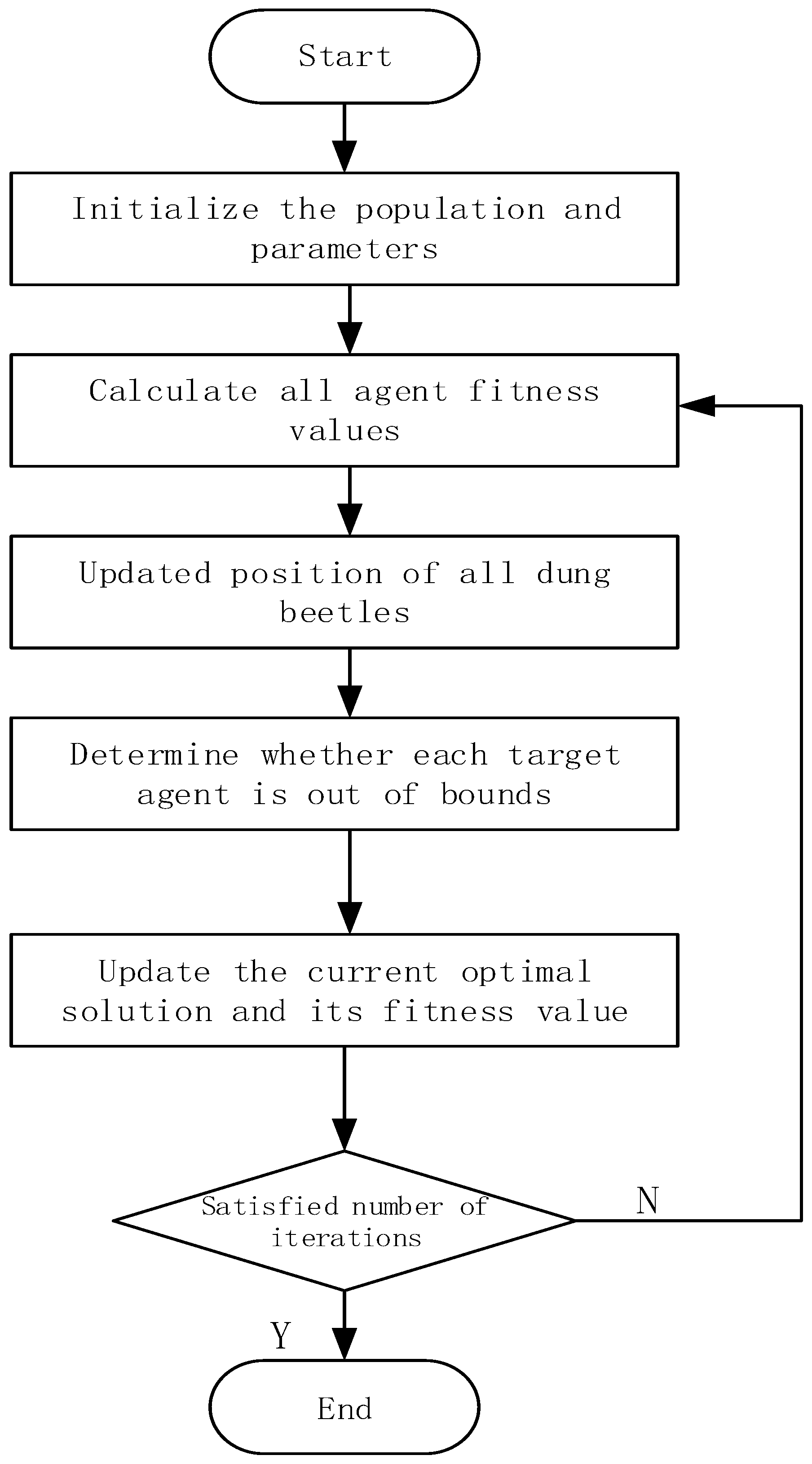
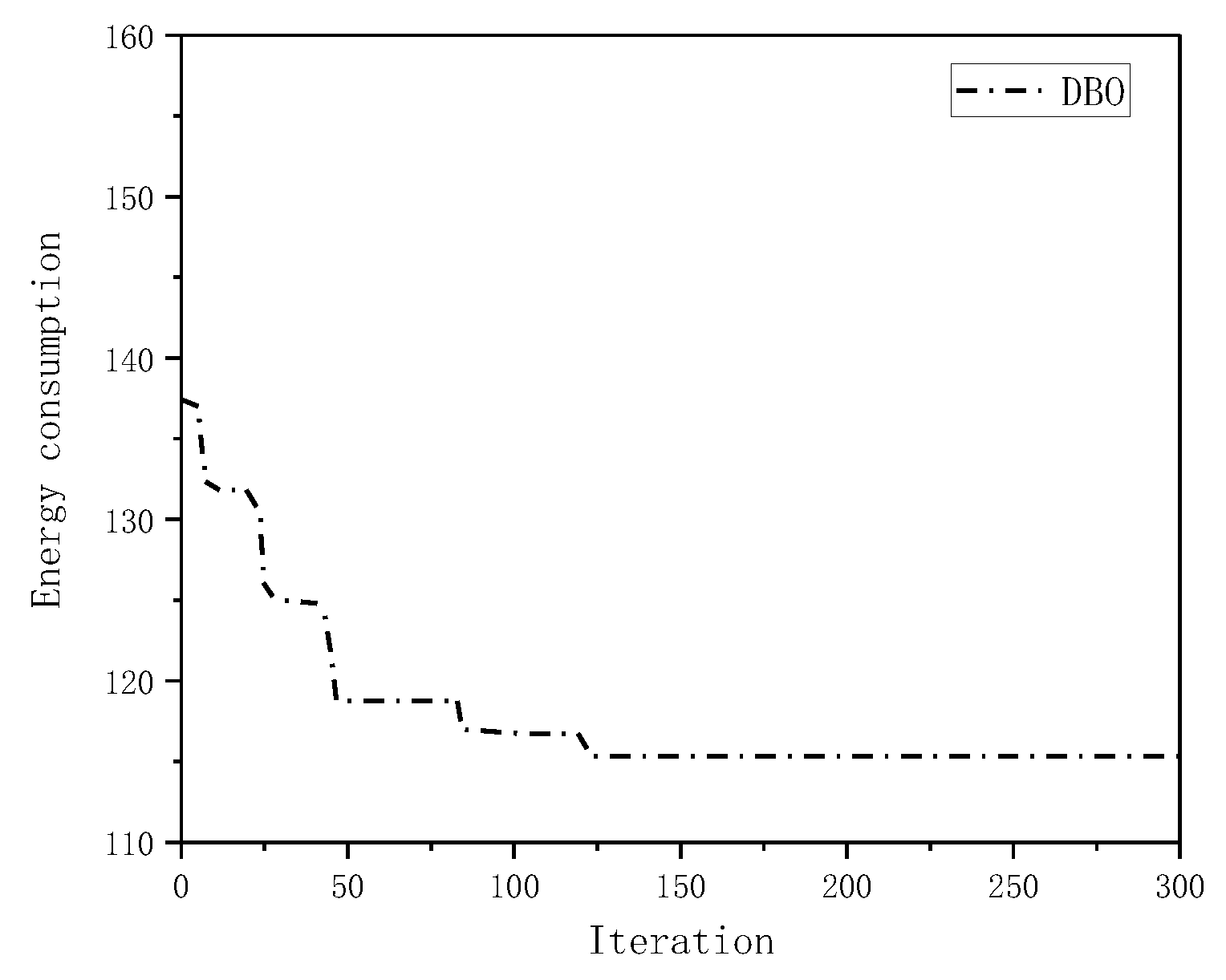
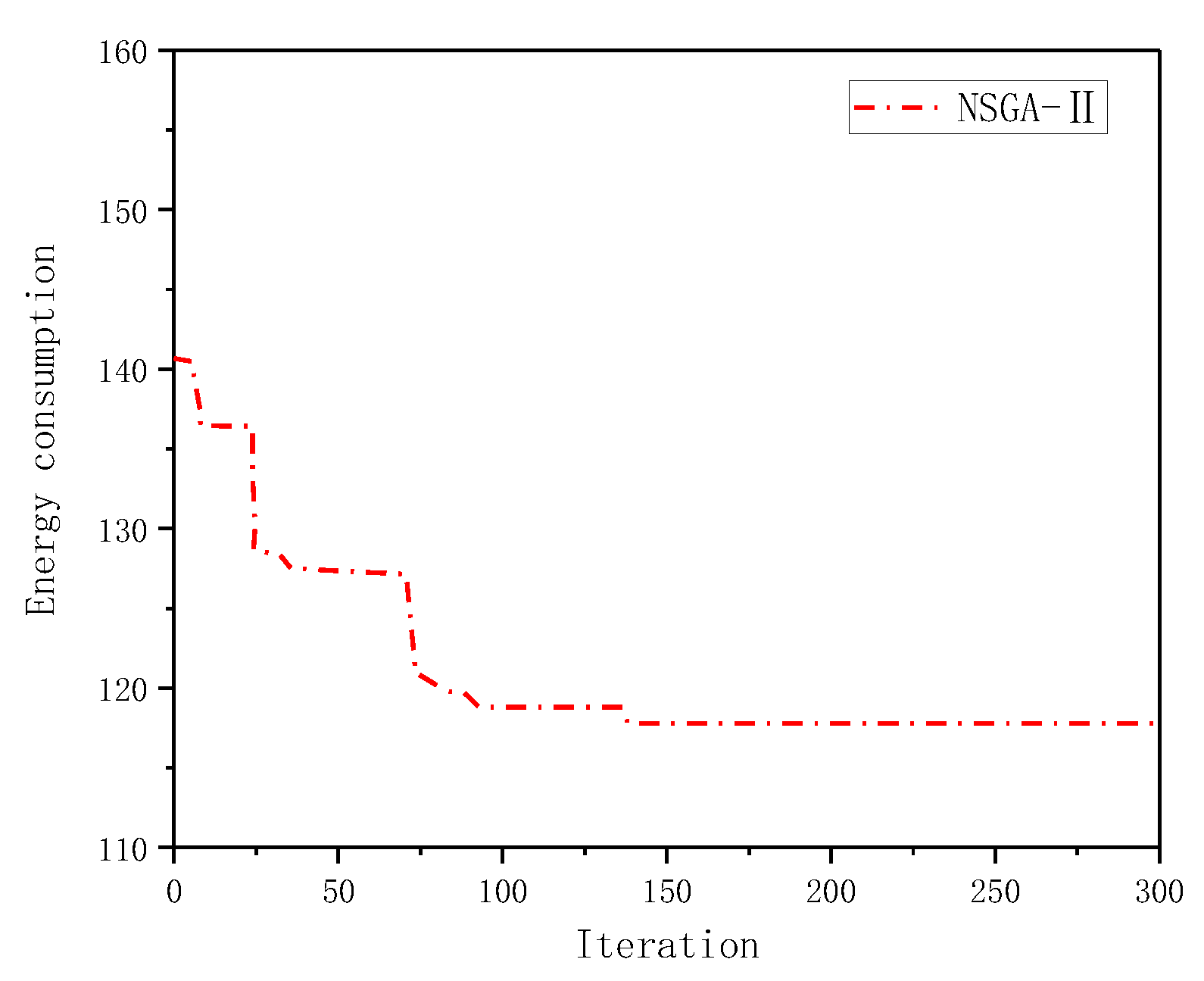
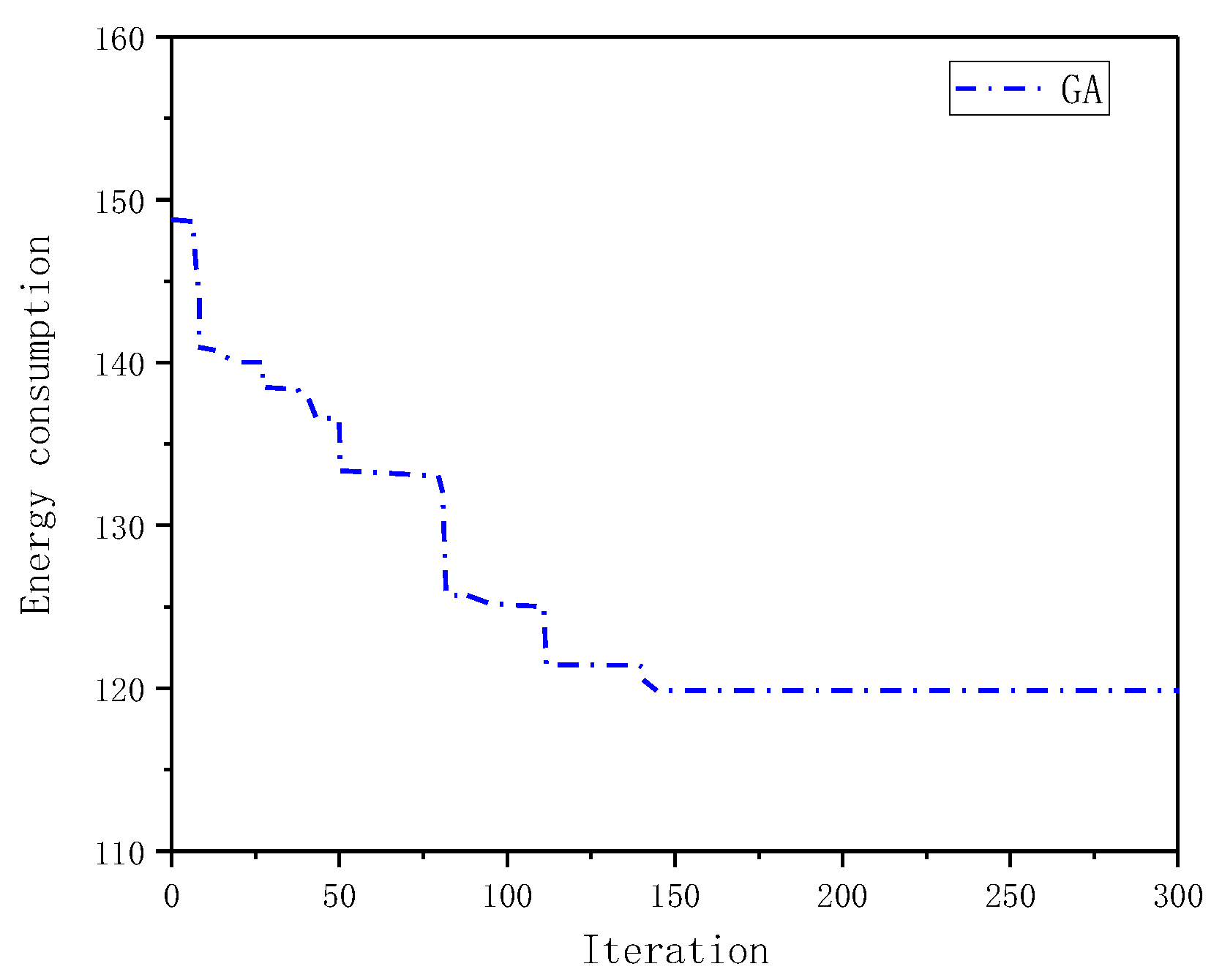
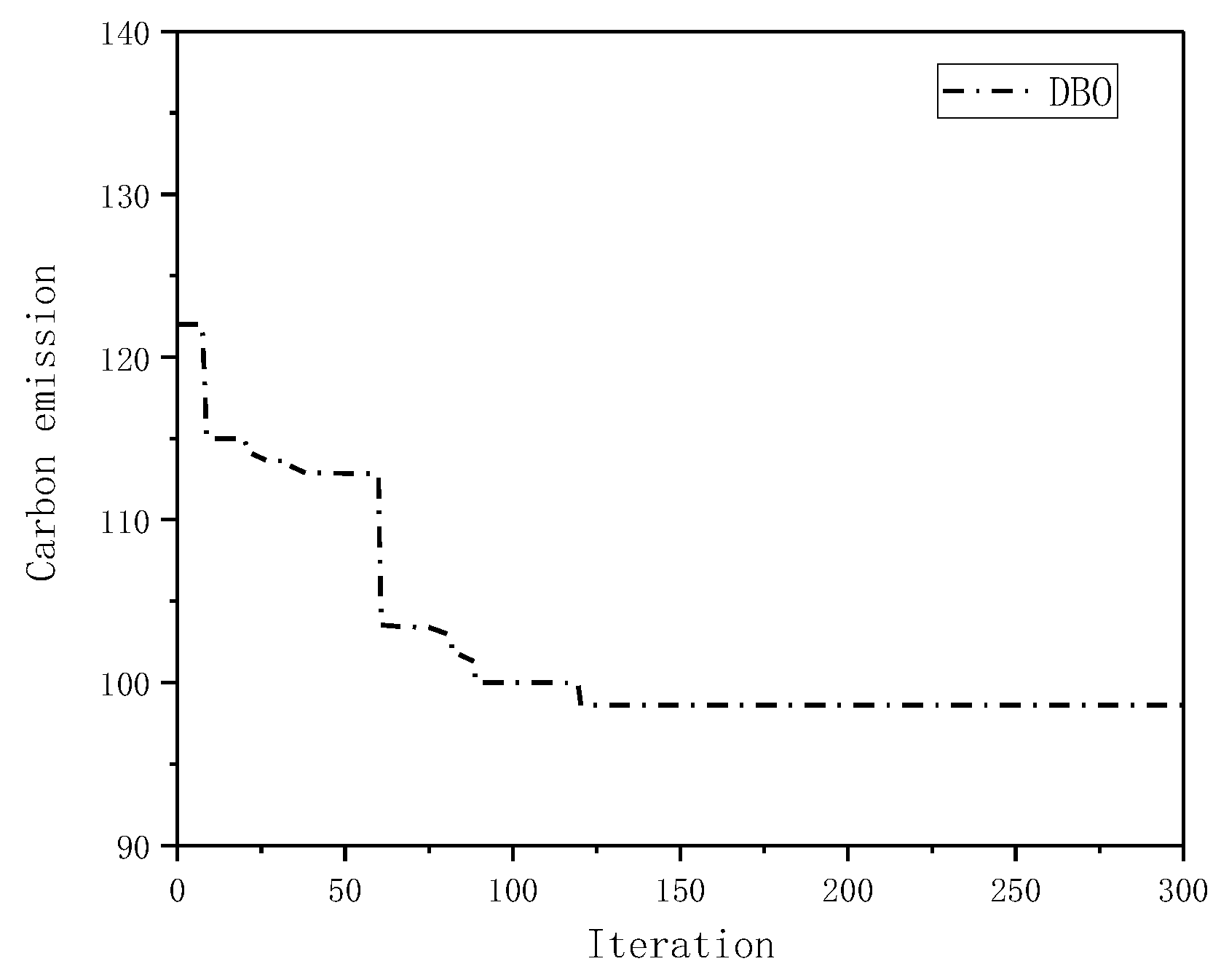
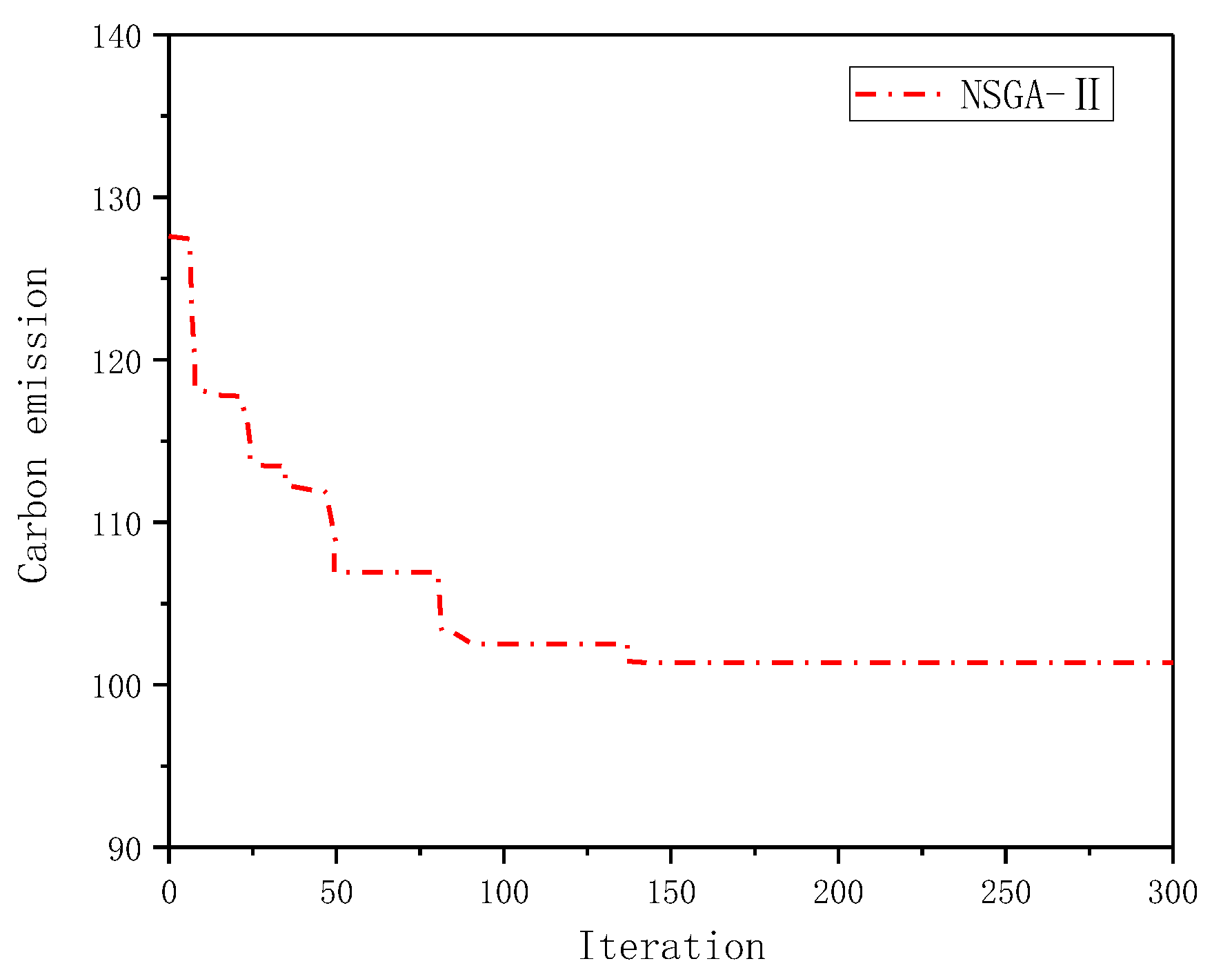
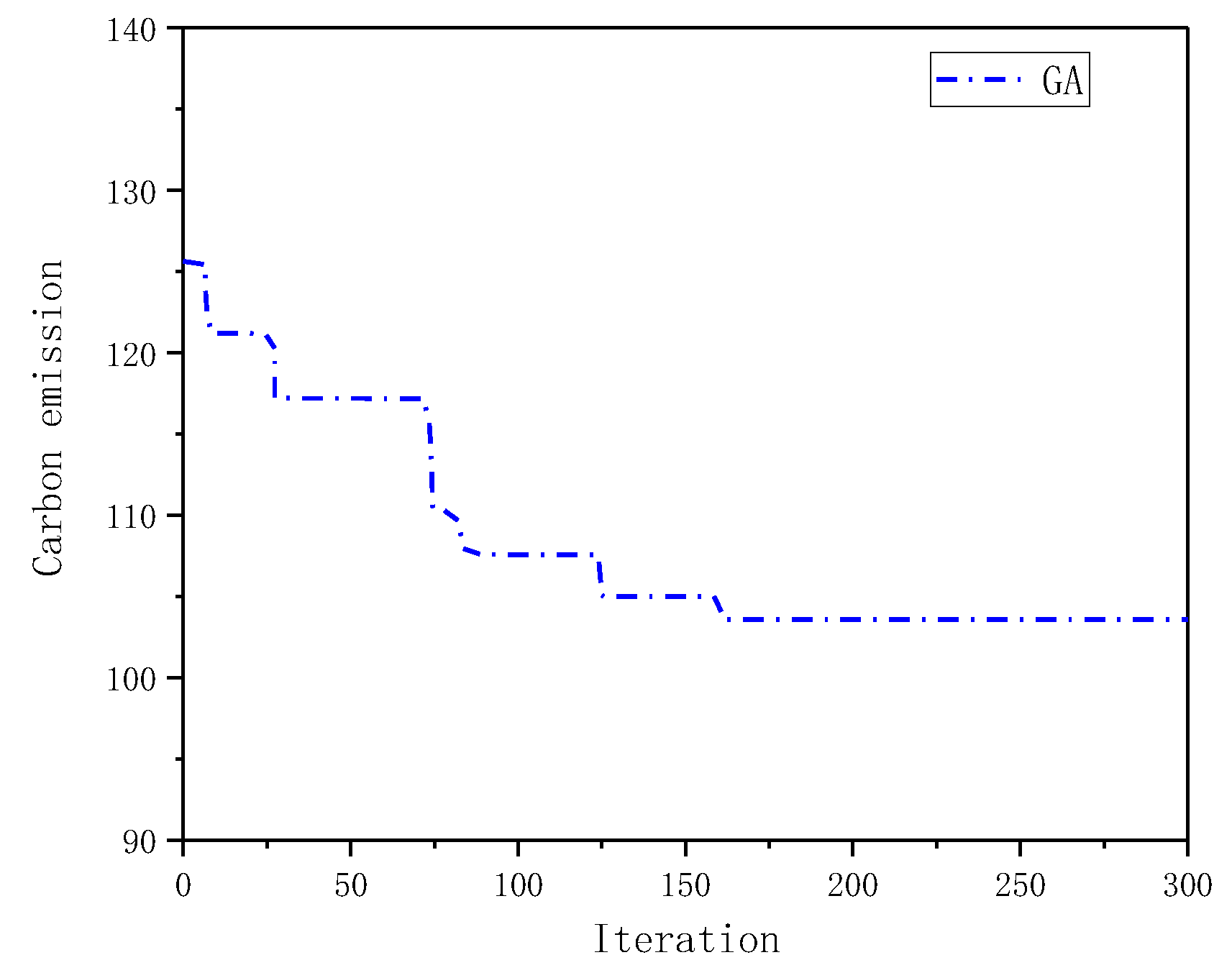
| Symbol | Description | Reference Value |
|---|---|---|
| fuel–air mass ratio | 1 | |
| engine friction coefficient | 0.2 | |
| g | weight constant | 9.8 |
| air drag coefficient | 0.7 | |
| air density | 1.2041 | |
| rolling resistance coefficient | 0.01 | |
| vehicle drivetrain efficiency | 0.4 | |
| diesel engine efficiency parameters | 0.9 | |
| road angle | 0 | |
| unit fuel and CO2 emission costs | 7.99 | |
| diesel fuel calorific value | 44 | |
| conversion coefficient | 737 |
| Station Number | 0 | 1 | 2 | 3 | 4 | 5 | 6 | 7 | 8 |
|---|---|---|---|---|---|---|---|---|---|
| 0 | 0 | 40 | 60 | 75 | 90 | 200 | 100 | 160 | 80 |
| 1 | 40 | 0 | 65 | 40 | 100 | 50 | 75 | 110 | 100 |
| 2 | 60 | 65 | 0 | 75 | 100 | 100 | 75 | 75 | 75 |
| 3 | 75 | 40 | 75 | 0 | 100 | 50 | 90 | 90 | 150 |
| 4 | 90 | 100 | 100 | 100 | 0 | 100 | 75 | 75 | 100 |
| 5 | 200 | 50 | 100 | 50 | 100 | 0 | 70 | 90 | 75 |
| 6 | 100 | 75 | 75 | 90 | 75 | 70 | 0 | 70 | 100 |
| 7 | 160 | 110 | 75 | 90 | 75 | 90 | 70 | 0 | 100 |
| 8 | 80 | 100 | 75 | 150 | 100 | 75 | 100 | 100 | 0 |
| Distribution Requirement | Station Number | |||||||
|---|---|---|---|---|---|---|---|---|
| 1 | 2 | 3 | 4 | 5 | 6 | 7 | 8 | |
| Material requirement | 20 | 25 | 15 | 23 | 16 | 32 | 20 | 10 |
| Service time | 1 | 0.5 | 1 | 1 | 1 | 1.5 | 1 | 0.8 |
| Waiting time | 0.8 | 0.9 | 1 | 0.5 | 0.5 | 1 | 0.8 | 0.9 |
| Time window | [6, 7] | [5, 7] | [1, 3] | [4, 7] | [3, 5] | [2, 5] | [4, 6] | [1.5, 4] |
| Distribution Vehicles | Distribution Path | Loading Rate | Delivery Distance (km) | Is It within the Time Window? |
|---|---|---|---|---|
| 1 | 0-3-2-5-0 | 86% | 5.8 | Yes |
| 2 | 0-6-4-0 | 53% | 3.9 | Yes |
| 3 | 0-8-7-1-0 | 78% | 7.3 | Yes |
Disclaimer/Publisher’s Note: The statements, opinions and data contained in all publications are solely those of the individual author(s) and contributor(s) and not of MDPI and/or the editor(s). MDPI and/or the editor(s) disclaim responsibility for any injury to people or property resulting from any ideas, methods, instructions or products referred to in the content. |
© 2023 by the authors. Licensee MDPI, Basel, Switzerland. This article is an open access article distributed under the terms and conditions of the Creative Commons Attribution (CC BY) license (https://creativecommons.org/licenses/by/4.0/).
Share and Cite
Xiao, Y.; Zhang, H.; Wang, R. Low-Carbon and Energy-Saving Path Optimization Scheduling of Material Distribution in Machining Shop Based on Business Compass Model. Processes 2023, 11, 1960. https://doi.org/10.3390/pr11071960
Xiao Y, Zhang H, Wang R. Low-Carbon and Energy-Saving Path Optimization Scheduling of Material Distribution in Machining Shop Based on Business Compass Model. Processes. 2023; 11(7):1960. https://doi.org/10.3390/pr11071960
Chicago/Turabian StyleXiao, Yongmao, Hao Zhang, and Ruping Wang. 2023. "Low-Carbon and Energy-Saving Path Optimization Scheduling of Material Distribution in Machining Shop Based on Business Compass Model" Processes 11, no. 7: 1960. https://doi.org/10.3390/pr11071960





